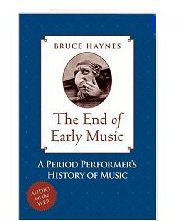The End of Early Music?
 I’ve been dipping into Bruce Hayne’s 2007 book The End of Early Music, and enjoying it in a somewhat argumentative way. It’s written in a lively fashion, in the tradition of and strongly influenced by writers such as Christopher Small and Richard Taruskin – writers who like to take what we thought we knew and reinterpret it until they jiggle us out of our complacency.
I’ve been dipping into Bruce Hayne’s 2007 book The End of Early Music, and enjoying it in a somewhat argumentative way. It’s written in a lively fashion, in the tradition of and strongly influenced by writers such as Christopher Small and Richard Taruskin – writers who like to take what we thought we knew and reinterpret it until they jiggle us out of our complacency.
Some people find this kind of style irritatingly unscholarly, but it’s great teaching material. Nothing like a spot of outrage to awaken the critical faculties, after all. So I find it easy to like a book that includes sentences like: ‘There was a time when “AUTHENTIC” sold records like “ORGANIC” sold tomatoes’.
Having said that, I’m not convinced that Haynes really follows his arguments through to the kill. There’s a sense of taking pot-shots at targets that are slightly too obvious, of setting up straw man arguments that are then easy to win. His general point that many of our modern ideologies about music originated in major cultural upheavals in the early nineteenth-century works fine, but then to lump all music from before this ‘Cultural Hinge’ into a single aesthetic seems as simplistic as the narratives that lump all of music history into periodic alternations of ‘classical’ and ‘romantic’ tendencies.
Likewise, his contention that ‘mainstream’ classical performance ‘insists on using a single performance style for the music of all periods’ is a sufficiently coarse stereotype that it rather undermines his argument. I don’t know whether he is deliberately ignoring or simply unaware of the extensive and scholarly literature on ‘style’ in traditional musicology, but he leaves it out of his definitions when he differentiates style as aesthetic or ideology from style as performance protocol.
Of course, what traditional musicology discussed as style was a music-analytic concept – think of Charles Rosen or Leonard Ratner or Jan LaRue on the classical style, for instance. This is a more composer-focused appraoch (and thus, in Haynes’s terms ‘Canonical’) than the performance protocol interest of historical instruments and playing techniques. It concerns itself with the characteristic relationships within musical content and their meanings (whether syntactical or contextual). The results were addressed directly to the performer relatively rarely within the texts, but the study of these kinds of texts in a performer’s training was well embedded, as was the notion that their playing would be informed by an understanding of style.
This isn’t to say that the scholarly study of historical performance protocols hasn’t made a wonderful and enlightening contribution to our artistic environment. But you don’t have to be quite so disrespectful to what is a rich performance tradition maintained by lots of dedicated and deep-thinking musicians in order to make that point.
So far, then, my response is one of modified rapture. I do like a book that makes me talk back to it, but I’m wishing he would make me work a bit harder to find things to critique. If I were still teaching undergraduate performance students, I would be using this as material for class discussions, but for postgrads I’d stick to Taruskin to explore this field I think.
...found this helpful?
I provide this content free of charge, because I like to be helpful. If you have found it useful, you may wish to make a donation to the causes I support to say thank you.
Archive by date
- 2024 (19 posts)
- 2023 (51 posts)
- 2022 (51 posts)
- 2021 (58 posts)
- 2020 (80 posts)
- 2019 (63 posts)
- 2018 (76 posts)
- 2017 (84 posts)
- 2016 (85 posts)
- 2015 (88 posts)
- 2014 (92 posts)
- 2013 (97 posts)
- 2012 (127 posts)
- 2011 (120 posts)
- 2010 (117 posts)
- 2009 (154 posts)
- 2008 (10 posts)










